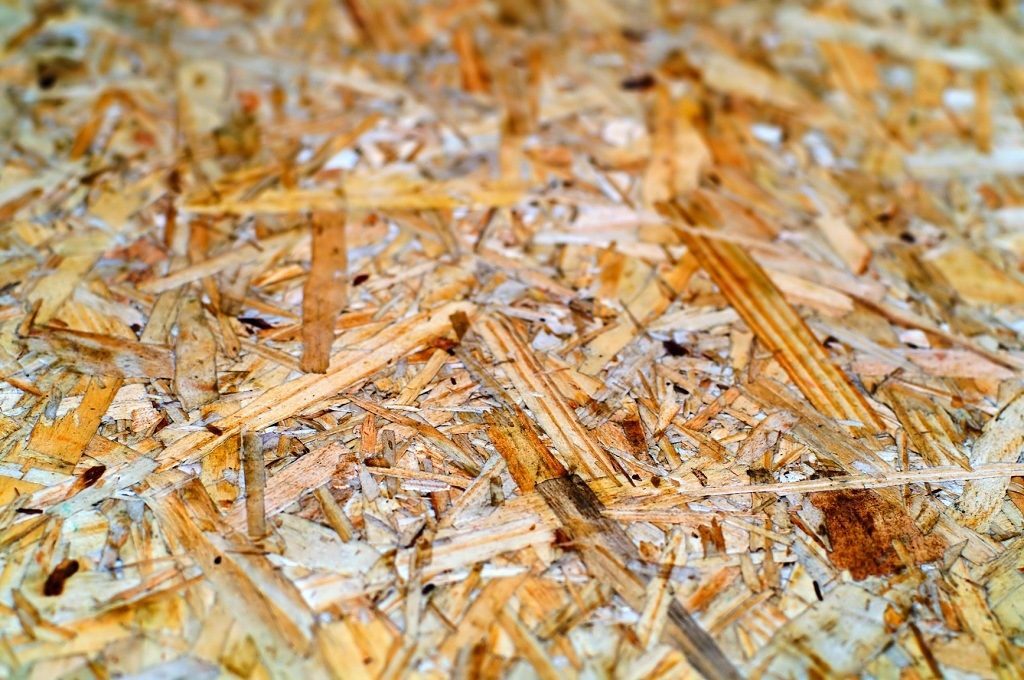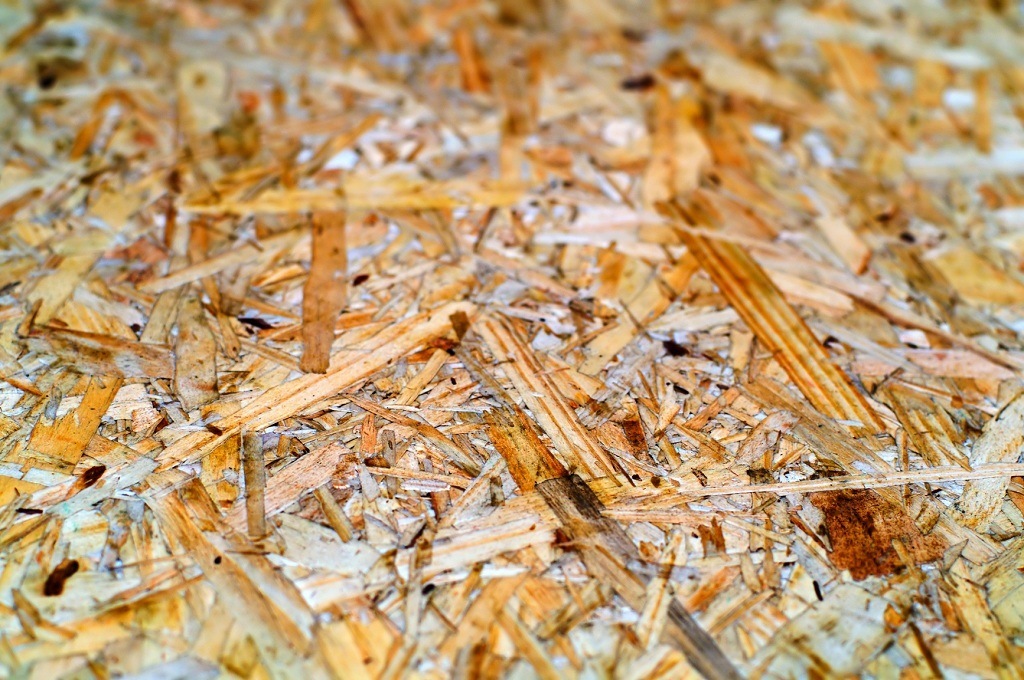Oriented strand board (OSB) was conceived in 1965 as an alternative for plywood. Originally called “waferboard,” it is sometimes mistakenly referred to as “chipboard.” But chipboards are made from waste material produced at lumberyards. The sizes of the chips are extremely inconsistent, negatively affecting the overall strength of the product. OSB on the other hand is made of rectangular wood strands, or “flakes” oriented so as to ensure that adjacent pieces have the gain running in different directions. Because flakes of wood are used, a sheet of OSB will have many more layers than a comparable thickness sheet of plywood, as many as 50.
In 2001 the total production of OSB overtook that of plywood for the first time and has remained in the lead ever since. The main reason for this is that the primary use of both softwood plywood and OSB is in the construction trade. OSB is less expensive and is approved for use in place of softwood plywood, as per the building code. Therefore, most contractors will opt for using OSB, unless a building specification specifically prohibits it.
The reasoning behind using OSB in place of softwood plywood is that OSB is supposedly stronger than plywood. But, and this is a very big but, that only refers to the shear strength of the plywood. To be clear, that’s the ability of the material’s internal structure to resist sliding against itself. In other words, it’s the ability for the material to resist the layers sliding across each other, if force is applied to one side going in one direction and to the other side going in the opposite direction. This can be imagined by putting the palms of your hands together and pushing one the hands in opposite directions; one towards the fingertips and the other towards the wrist.
Why this particular specification is singled out and used as “proof” that OSB is as good as plywood baffles me. I can think of no situation in which shear strength is going to be all that important in keeping a home from falling apart or suffering some other calamity. Nevertheless, people who are smarter than I have decided that shear strength of OSB is an important specification.
The one place where that shear strength is extremely important is when OSB is used in the webbing of wood I-joists. Plywood is never used for the manufacture of those I-joists, because it does not have the necessary shear strength.
Please note that this does not mean that OSB is stronger than any other type of plywood, based on any other sort of testing that might be done. I just saw a video of simulated hurricane testing, in which a 2”x 4” was shot at pieces of 5/8” OSB and 5/8” softwood plywood mounted over windows as simulated hurricane protection. While the plywood had no problem in stopping the 2”x 4” fired at it at 34 MPH, the same test, when performed on the OSB caused the 2”x 4” to fly right through the window, leaving a nice neat hole in the OSB.
Besides I-joists, OSB is most commonly used for sheathing on wood-structure homes. This includes roof sheathing, wall sheathing and floor sheathing, all of which applications are approved by the building code. It is the main substitute material used to replace construction-grade softwood plywood in these applications.
As market forces have caused the price of wood to rise in 2021, it has also affected the cost of OSB, just like any other wood product. Depending on the part of the country, wood prices are inflated from 300 to over 500 percent of pre-pandemic costs. This has caused the price of a new home to go up by roughly 30%, something that could lead to another housing crash in the future.
The big question at the moment is how long wood prices will remain high. As of the time of this writing, it appears that they will remain high at least through 2022. But with inflation on the rise, in part due to the high cost of wood products, it could remain high much longer and may not return to pre-pandemic levels. There’s really no way of knowing at this time just what the future price of OSB or any other wood product is going to be.
That raises a second question: with OSB being so expensive, is there something that can be used as a replacement for it, in sheathing a home?
On one hand, that question seems a bit ridiculous, as OSB was conceived and manufactured as a replacement for construction-grade plywood, in order to save costs. On the other hand, with how the cost of wood has increased, finding a lower-cost replacement for home sheathing will help to reduce the cost of building a home.

In fact, there are two products which can be used:
- All three types of rigid-foam insulation, to include expanded polystyrene (EPS), extruded polystyrene (XPS) and polyisocyanurate can be used as substitutes for OSB in sheathing exterior walls and roofs. However, it must be understood that these materials do not have the same inherent strength of OSB or plywood and will not perform equally. However, they do have the advantage that they resist water and moisture well.
- Fiberglass-faced gypsum panels were developed specifically for use as a replacement for OSB and plywood in providing exterior sheathing. These materials are more durable and stiffer than rigid-foam insulation. It has become more common for use as a replacement for OSB as wall sheathing; however, even though manufacturers state that it can be used for roof sheathing, many other experts say that it should not be. This material is much more water-resistant than OSB and plywood, which is a plus during construction, before the building is fully dried-in.
It should be noted that before the prices of wood products soared, these were not cost-effective options. However, with the current high cost of OSB, they are both worth consideration. Fiberglass-faced gypsum board is slightly more expensive than rigid-foam insulation, but it is also stronger, able to withstand damage from windblown items better.




